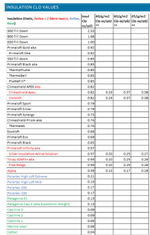cuerro viejo
WKR
- Joined
- Apr 1, 2013
- Messages
- 2,666
Core system- 20 degrees to 100+
sitka evo
sitka ambient hoody
Kuiu 120 shirt
Prana zion pant
late season pant option <20
SG De Havill
base layer pant-
light -kuiu 120 zip off
heavy-SG helo
Puffy-
Mountain hardware Ghost
Rain- normally just use stika evo
lots of rain: columbia-out dry extreme
late season option - SG M7
sitka evo
sitka ambient hoody
Kuiu 120 shirt
Prana zion pant
late season pant option <20
SG De Havill
base layer pant-
light -kuiu 120 zip off
heavy-SG helo
Puffy-
Mountain hardware Ghost
Rain- normally just use stika evo
lots of rain: columbia-out dry extreme
late season option - SG M7

